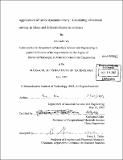| dc.contributor.advisor | Gerbrand Ceder. | en_US |
| dc.contributor.author | Wu, Eric John, 1974- | en_US |
| dc.contributor.other | Massachusetts Institute of Technology. Dept. of Materials Science and Engineering. | en_US |
| dc.date.accessioned | 2006-03-24T18:02:45Z | |
| dc.date.available | 2006-03-24T18:02:45Z | |
| dc.date.copyright | 2002 | en_US |
| dc.date.issued | 2002 | en_US |
| dc.identifier.uri | http://hdl.handle.net/1721.1/29916 | |
| dc.description | Thesis (Ph.D.)--Massachusetts Institute of Technology, Dept. of Materials Science and Engineering, 2002. | en_US |
| dc.description | Includes bibliographical references (leaves 97-114). | en_US |
| dc.description.abstract | This thesis applies the theory of lattice dynamics towards two applications: vibrational entropy in alloys and dielectric absorption in oxides. Vibrational entropies between ordered-L12 and disordered phases in the Au3Cu, Cu3Au, Cu3Pd, Pd3Cu, Cu3Pt, Au3Pd, and Pd3Au systems are calculated. This study was done using first-principles energy calculations and the supercell method. Calculated values of ASʻrder-disorder ranged between -0.05 - 0.07 kB. Length-dependent transferable force constants are used to predict vibrational entropies in the Au-Cu, Au-Pd, and Cu-Pd systems. The stiffness of these force constants is obtained from a function that depends on bond length; this function is determined by fitting polynomials to a small set of calculated force constants. Once a function that describes force constant stiffness vs. bond length is determined for a particular pair type, the function can be transferred between different configurations and chemical systems to construct force constants for an arbitrary structure. These transferable force constants are shown to accurately predict vibrational entropies of L12-ordered and disordered phases in Cu3Au, Au3Pd, Pd3Au, Cu3Pd, and Pd3Au. The dielectric absorption at microwave frequencies in binary oxides is calculated within an empirical Buckingham energy model. For MgO, the calculated dielectric losses at room temperature agrees relatively well with experiments, and the temperature dependence is in qualitative agreement. We also model systems to gain insight into the effects of different cation sizes and masses. We explain our results in terms of anharmonic forces, atomic masses, and phonon dispersion curves. | en_US |
| dc.description.statementofresponsibility | by Eric John Wu. | en_US |
| dc.format.extent | 114 leaves | en_US |
| dc.format.extent | 4160027 bytes | |
| dc.format.extent | 4159832 bytes | |
| dc.format.mimetype | application/pdf | |
| dc.format.mimetype | application/pdf | |
| dc.language.iso | eng | en_US |
| dc.publisher | Massachusetts Institute of Technology | en_US |
| dc.rights | M.I.T. theses are protected by copyright. They may be viewed from this source for any purpose, but reproduction or distribution in any format is prohibited without written permission. See provided URL for inquiries about permission. | en_US |
| dc.rights.uri | http://dspace.mit.edu/handle/1721.1/7582 | |
| dc.subject | Materials Science and Engineering. | en_US |
| dc.title | Applications of lattice dynamics theory : calculating vibrational entropy in alloys and dielectric losses in ceramics | en_US |
| dc.type | Thesis | en_US |
| dc.description.degree | Ph.D. | en_US |
| dc.contributor.department | Massachusetts Institute of Technology. Department of Materials Science and Engineering | |
| dc.identifier.oclc | 51722988 | en_US |
